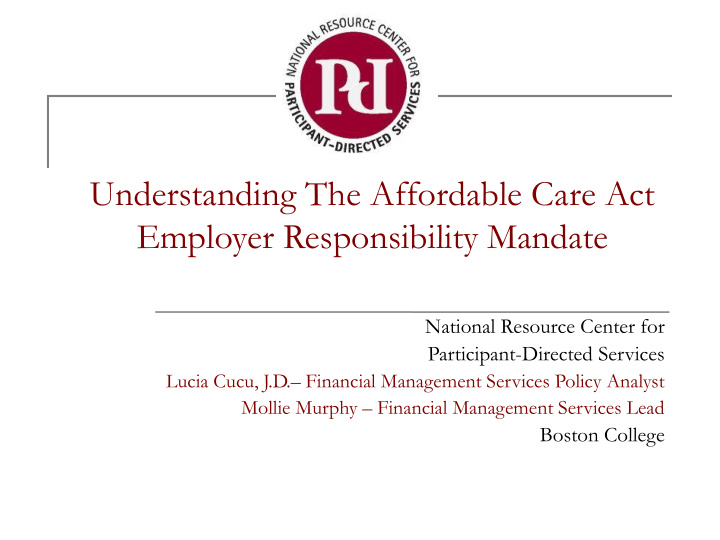



Understanding The Affordable Care Act Employer Responsibility Mandate National Resource Center for Participant-Directed Services Lucia Cucu, J.D. – Financial Management Services Policy Analyst Mollie Murphy – Financial Management Services Lead Boston College
Welcome! Joint webinar with FMS Members and Program Members Over the phone, please press */# to mute/unmute your line Following the webinar, you will receive a recording and a written Q&A summary Announcement: 2013 National Inventory of Participant- Directed Programs
Presenter Introductions Lucia Cucu , Mollie J.D. Murphy , FMS Policy FMS Lead Analyst 3
The Affordable Care Act Employer Responsibility Mandate Promulgated as part of the Patient Protection and Affordable Care Act. Requires employers with 50 or more full-time equivalent employees to offer affordable health care coverage to their full-time employees and their dependents, or pay a penalty. What is a full-time equivalent employee? The monthly hours of all part time employees are added and divided by 120 to obtain the number of full-time equivalent employees.
Who is the employer? The IRS will use common law rules The 50 employee threshold means the mandate: Will likely apply in an Agency with Choice scenario. May apply in programs that use a Public Authority to provide services. Probably will not apply in a Fiscal/Employer Agent scenario, so long as the participant is considered the employer (because a single participant would not have 50 employees).
Related entities and anti-abuse rules Entities that are part of the same control group or affiliated service group are aggregated for the 50-employee test. However, penalties are calculated separately for each entity. Anti-abuse rules: Can’t split an employee’s hours between different agencies to keep the worker part-time for the purpose of avoiding the rules. IRS may scrutinize arrangements where an employee provides services to the same participant through different agencies.
Who must be offered coverage? Only full-time employees Full-time means 30 or more hours per week (130 per month equivalent may be used). Part-time employees do not have to be offered coverage. And their dependents Includes children under 26. Does not include spouses. d their dependents 90-day waiting period allowed for new employees.
What about employees whose hours vary from month to month? Safe-harbor method for determining the full-time status of variable hour employees: Measure an employee’s hours during a period of up to 1 year. Full-time status during the next year determined based on the previous year’s hours.
How the safe-harbor method works Measurement and stability periods overlap. A worker who stays full-time will be continuously covered after the first measurement period. Optional administrative period.
Affordability requirement Coverage must be affordable, meaning: the employee’s share of the premium for self -only coverage cannot exceed 9.5 percent of the employee’s household income, or safe harbor: coverage is deemed affordable if the cost to the employee does not exceed 9.5% of wages from Box 1 of Form W-2, Wage and Tax Statement .
Penalties If coverage is not offered to all full-time employees: $2,000 per year per employee for all full-time employees, excluding 30 employees. No penalty if only up to 5 or 5% of employees are not offered coverage (to account for administrative errors). If coverage is offered but is not affordable: $3,000 per year, but only for those employees for whom coverage is unaffordable. Cannot exceed the total penalty that would have been imposed if no coverage was offered.
Impact of the Medicaid expansion What is the Medicaid expansion? All adults with income <138% of FPL eligible for Medicaid (in participating states). Expanded coverage for single adults. Income threshold raised, increasing the number of eligible persons. No asset test required for eligibility. States have the option to adopt or reject the expansion.
Which states will adopt the expansion? Source: The Kaiser Family Foundation. Current as of July 1, 2013.
Implications for employers Employers must nevertheless offer coverage to all full-time employees, unless all employees qualify for Medicaid. Even one non-qualifying employee can trigger the $2,000 per employee penalty for all employees. So when does Medicaid reduce penalties? Penalty for unaffordable coverage ($3,000/employee) does not apply with respect to an employee if: The employer offers coverage, The coverage is unaffordable for the employee, and The employee is eligible for Medicaid.
When does the mandate go into effect? Employer mandate delayed until 2015. No penalties will apply for 2014. Delay was announced on the Treasury Blog two weeks ago. Official rules to be released shortly. We will keep members updated.
Further research at NRCPDS Gathering and analyzing employee data from existing programs. Determining the percentage of workers who would typically be eligible for Medicaid expansion. Calculating potential penalties under various scenarios. Comparing penalty cost with the cost of providing insurance.
Questions/Comments? Ask your questions or share your comments now via phone or using the Q&A box on your screen
Recommend
More recommend